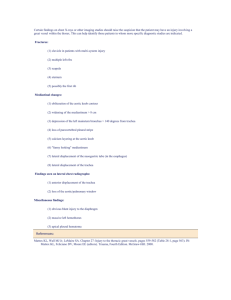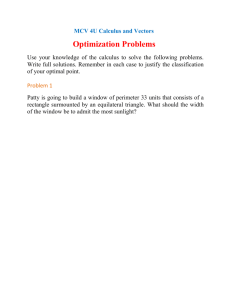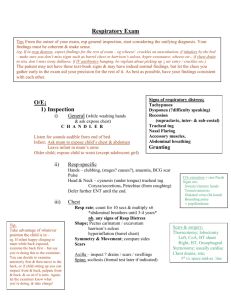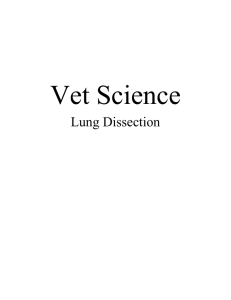Examination of the Respiratory System
advertisement
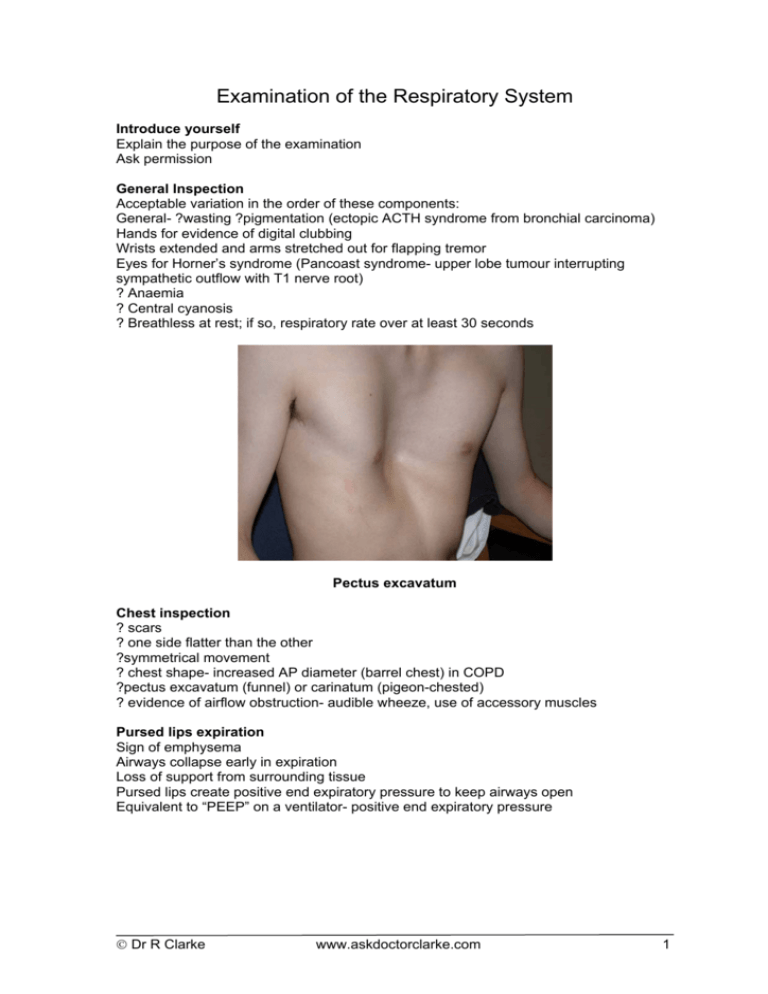
Examination of the Respiratory System Introduce yourself Explain the purpose of the examination Ask permission General Inspection Acceptable variation in the order of these components: General- ?wasting ?pigmentation (ectopic ACTH syndrome from bronchial carcinoma) Hands for evidence of digital clubbing Wrists extended and arms stretched out for flapping tremor Eyes for Horner’s syndrome (Pancoast syndrome- upper lobe tumour interrupting sympathetic outflow with T1 nerve root) ? Anaemia ? Central cyanosis ? Breathless at rest; if so, respiratory rate over at least 30 seconds Pectus excavatum Chest inspection ? scars ? one side flatter than the other ?symmetrical movement ? chest shape- increased AP diameter (barrel chest) in COPD ?pectus excavatum (funnel) or carinatum (pigeon-chested) ? evidence of airflow obstruction- audible wheeze, use of accessory muscles Pursed lips expiration Sign of emphysema Airways collapse early in expiration Loss of support from surrounding tissue Pursed lips create positive end expiratory pressure to keep airways open Equivalent to “PEEP” on a ventilator- positive end expiratory pressure Dr R Clarke www.askdoctorclarke.com 1 Pursed lips expiration Palpation Trachea Chest expansion Tactile vocal fremitus Trachea In loss of lung volume, the trachea is deviated towards the affected side Very rarely, deviated away from the affected side (tension pneumothorax or massive pleural effusion) Collapse of Left Lower Lobe Trachea deviated towards affected side Loss of lung volume Pneumonectomy TB or unilateral fibrosis for any reason Collapse of a lobe Dr R Clarke www.askdoctorclarke.com 2 Expansion Grip the skin tightly to make it taut; if not the laxity might reduce any asymmetry in movement of the chest wall, making it less obvious Expansion is reduced on the side of the lesion Tactile vocal fremitus Reduced with pleural effusions, collapse Probably no need to do this as well as vocal resonance (on auscultation) Increased with consolidation- better conduction through consolidated lung tissue Vocal resonance also increased- whispering pectoroloquy; a whisper is louder on the side of the consolidation Percussion Dull over pleural effusion, lobar pneumonia and collapse Increased in emphysema Auscultation Normal breath sounds are vesicular and do not have a gap between inspiration and expiration Bronchial breathing- smooth blowing quality (non-vesicular) and distinct gap between inspiration and expiration Signs of CO2 retention Flapping tremor; if found look for other signs: Tachycardia with high volume “bounding pulse” Warm peripheries Dilated superficial veins Reduced conscious level Papilloedema Conditions with specific patterns of physical signs • Airflow obstruction • Pleural effusion • Collapse • Pneumothorax • Tension pneumothorax • Consolidation Airflow Obstruction • Audible wheeze • Accessory muscles • Barrel chest • Tracheal tug- exaggerated descent on inspiration • Hyper-resonance to percussion • Prolonged expiratory phase • Wheezes Dr R Clarke www.askdoctorclarke.com 3 Effusion and Collapse • Reduced expansion • Reduced tactile vocal fremitus • Dull to percussion • Reduced air entry Pleural Effusion Stony dull to percussion Bronchial breathing above it Trachea normal If massive, trachea pushed away from the side of the effusion • • • • Massive Pleural Effusion Trachea deviated AWAY from affected side Loss of lung volume Pneumonectomy Collapsed lobe Treated “old” tuberculosis • • • Dr R Clarke www.askdoctorclarke.com 4 In loss of lung volume the trachea is deviated towards the affected side Collapse of left lung Trachea deviated to left Heart displaced to left (Normally one third of heart shadow visible on right of spine) Pneumothorax Reduced expansion Reduced or absent tactile vocal fremitus Hyper-resonant percussion Reduced or absent breath sounds Trachea normal unless tension • • • • • Pneumothorax Dr R Clarke www.askdoctorclarke.com 5 Trachea deviated AWAY • Increase in volume of pleural space • Massive pleural effusion • Tension pneumothorax (see x-ray): mediastinal shift to right Consolidation • Reduced expansion • Dullness to percussion • Bronchial breathing • Coarse inspiratory crackles • Increased tactile vocal fremitus • Increased vocal resonance (whispering pectoriloquy) Dr R Clarke www.askdoctorclarke.com 6
